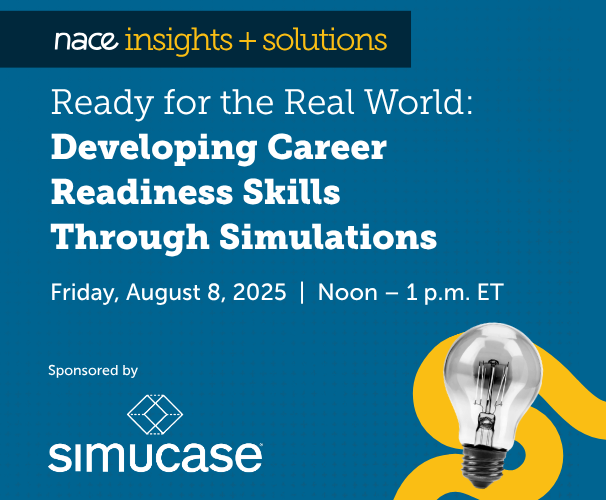NACE Journal / Fall 2024
For years, diversifying its workforce has been a focus within the STEM industry (science, technology, engineering, and math). Moreover, numerous programs and initiatives exist to entice students of color to the STEM fields. For instance, the United Negro College Fund has partnered with Bayer Fund, which offers scholarships and resources to STEM students at Historically Black Colleges and Universities.1 Additionally, in 2022, the Biden Administration launched the Raise the Bar: STEM Excellence for All Students Initiative, which focuses heavily on career readiness and global competitiveness regardless of background.2
Despite such efforts, data show that in 2021 that Black (9%) and Hispanic (15%) workers represented less than 25% of the STEM workforce.3 In a 2020 Forbes blog, Talia Milgrom-Elcott charged that the nation has discouraged students of color from pursuing STEM, raising a moral issue that this nation has yet to address.4 As students of color are eager to attend higher education institutions and advance their economic wealth, many barriers hinder their academic success.
Historical Context
Historically, STEM has been a lucrative industry in terms of economic mobility. However, the American education system has struggled to move the needle forward in a nation where STEM teachers have been limited and equitable access to STEM courses is rare.
Students of color have often encountered a lack of culturally competent faculty and staff, racial disparities, higher dropout rates, and financial burdens. Regarding curriculum development, Milgrom-Elcott notes that many of the stories about contributions to STEM are centered around white men, creating a learning environment that has been minimizing and harmful for students of color.5
Similarly, The Clay Center for Young Healthy Minds notes that students of color are more likely to encounter racism, microaggressions, physical and verbal assaults, and cyberbullying, which have negatively impacted their mental health.6 For students, these experiences often lead to loneliness and questioning of whether they belong at their institutions. In addition, the National Library of Medicine cited a 2019 report that 40% of Black students have transitioned out of STEM majors.7 On the other hand, the Pew Research Center said that although Hispanic students have increasingly earned STEM degrees, they remain underrepresented amongst STEM degree recipients.8
Even though these historical factors have been widely shared, there are perceived barriers for STEM students of color that aren’t as apparent. This article focuses on data collected by the Network and Cultural Assets research team, which is part of the Center for Research on College-Career Transition at the University of Wisconsin-Madison and which focuses on the social network and cultural assets of students of color, specifically Hispanic students, in relation to their career development.
In 2023, we collected data from self-identified Hispanic students (N=80) enrolled at six institutions in the University of Texas System regarding their social networks and cultural assets. From that data, we examined perceived barriers.
Shared and Perceived Barriers for Hispanic STEM Students
Our qualitative data found two main themes—financial concerns and intrinsic motivation—as well as other related themes, including student/work balance and mental health issues.
Financial concerns and student/work balance: When considering the financial worries of Hispanic STEM students, there is often the notion that these students only need financial assistance to cure financial concerns. However, this theme is highly multidimensional and includes financial worries and finding balance with the pressures of attending college. For example, one participant from the University of Texas at Rio Grande Valley reported that “the financial part of my education has always been challenging. My parents are not the wealthy kind that can help me with paying for my education. So, I've had to find jobs. ... [and] it has always been a struggle to balance work with education and other extracurricular activities."
Various participants echoed that they must work multiple jobs to pay for school and expenses, e.g., housing, including a University of Texas at El Paso (UTEP) student who noted, "I always have to keep at least two jobs to have an apartment."
Although their financial worries are at the height of their perceived barriers, balancing and grappling with their student identity is often impacted. Various participants noted the difficulty in managing their identity, including one who described the challenge in this way: "I would like just to be a student, but I have to work as well, so that's been difficult for me." Many of these students navigate their first-generation identity, which requires them to learn processes related to financial aid and the FAFSA. Participants mentioned leaning on financial aid to cover their tuition, books, and lodging. However, in particular, participants cited the FAFSA application as being stressful in terms of the materials required to complete the application and the language/jargon used in it.
Career doubts and intrinsic motivation: For many students of color, going to college is a means to advancing economically, socially, and personally. For one University of Texas at Rio Grande Valley participant, that pursuit comes with doubts: "Do I want to do this for the rest of my life is the scariest [doubt] for any field of study really, especially for medicine, since it's more rigorous and ... you're going to have to do four years of your bachelor’s, another four years of med school, and another two or three years of [additional work]. That's already around 12 years that you're going to have to dedicate your life to, and you're debating if you want to do this. It's a very hard barrier to overcome."
On the other hand, a participant from the University of Texas at Dallas battled the realities of systemic barriers, noting, "I just felt like I wasn't up to [the level of other students] here because they have already been … to such good schools. I had a terrible education where I grew up.”
Such self-doubt often fuels students’ motivation. For Hispanic STEM students, representation has played a significant role in why they are motivated to enter a field where Hispanic students are underrepresented. As a participant from UTEP reported, "[For me, it] became a little bit more personal because [I saw at organizations I visited] that the Latinos are the minority in the STEM field, that Latinos and the Black community are the minority. You can tell the difference. It's obvious. Once I get to a place, I'm two out of 100, and it is crazy. [Also,] there are not a lot of Ph.D. professors who are Latinos. So, I want to be part of the Latino community that pushes [forward] on STEM." Through their desire to change the narrative, these students perceive their barriers as new beginnings that can move the needle forward.
Mental health: Mental health has become a factor for many college-aged students. The student participants were transparent about the struggles they are plagued with while navigating their various identities. One of the participants from the University of Texas at San Antonio noted, "One of my grandparents passed away. ... That was really challenging for me. [I also experienced some depression. In terms of challenges], those are probably the only two challenges I faced. Most of them just come from me, less from school."
As a connection to career doubts, participants’ mental health is congruent with students' navigation within STEM careers. For example, a University of Texas at Arlington participant referenced experiencing mental health barriers and noted that “school takes a lot out of you, and it's tough to be a college student. So mental health barriers are like, ‘Do I want to put myself through that?’"
It is essential to understand how mental health for historically underrepresented groups interferes with their career journey along with other barriers often unshared outside of the individual’s network.
Transcending Barriers and Rising Through Engagement
As we strive to move the needle forward to advance diversity in the STEM industry, there are four areas we need to focus on:
1. Identifying the "why"—why individuals of color should be in STEM and how they can contribute their assets.
2. Offering additional funding up front, when students of color declare a STEM major.
3. Offering opportunities that will financially benefit students of color to engage in internships, conferences, and organizations within STEM.
4. Supporting groups led by STEM professionals to engage with and motivate students to see themselves as STEM professionals.
The barriers Hispanic STEM students commonly share focus heavily on the historical components that have plagued them. However, their identities are multifaceted and interconnected, often influencing and impacting their journey in pursuing STEM careers. As the participants stated in their stories, they come to college to be students, but their lived experiences are mixed with the extra pressures of funding their education and excelling and representing their communities. As practitioners and scholars, we can and must do three things to help them:
- Acknowledge that multiple factors can impact their lives simultaneously.
- Allow these students to share their thoughts, ideas, and concerns specific to their needs. Intentional planning, programming, advising, and implementation could advance their engagement through this practice.
- Acknowledge that what has worked for one individual's career journey may not work for another’s journey. Create space for these students to be individuals.
Endnotes
1 Cultivating a Growing Need for STEM Expertise (2023, February 23). United Negro College Fund. Retrieved from https://uncf.org/the-latest/cultivating-a-growing-need-for-stem-expertise.
2 Retrieved from https://www.ed.gov/about/ed-initiatives/you-belong-stem.
3 Diversity and STEM: Women, Minorities, and Persons With Disabilities (2023, January 30). National Center for Science and Engineering Statistics. Retrieved from https://ncses.nsf.gov/pubs/nsf23315/report.
4 Milgrom-Elcott, T. (2020, September 24). Students of Color Are Missing Out on STEM Opportunities, So the Planet Is Missing Out on Their Brilliance. Here’s How We Finally Achieve Equity in High School STEM. Forbes. Retrieved from www.forbes.com/sites/taliamilgromelcott/2020/09/24/students-of-color-are-missing-out-on-stem-opportunities-so-the-planet-is-missing-out-on-their-brilliance-heres-how-we-finally-achieve-equity-in-high-school-stem/?sh=479f68be5148.
5 Ibid.
6 Watkins, K.B. & Beresin, G. (n.d.). College Students of Color: Overcoming Racial Disparities and Discrimination. The Clay Center for Young Healthy Minds. Retrieved from www.mghclaycenter.org/parenting-concerns/young-adults/college-students-of-color/.
7 Suran, M. (2021, June 2). Keeping Black Students in STEM. National Library of Medicine. Retrieved from https://pmc.ncbi.nlm.nih.gov/articles/PMC8202006/.
8 Funk, C. & Lopez, M.H. (2022, June 14). Many Hispanic Americans See More Representation, Visibility as Helpful for Increasing Diversity in Science. Pew Research. Retrieved from www.pewresearch.org/science/2022/06/14/many-hispanic-americans-see-more-representation-visibility-as-helpful-for-increasing-diversity-in-science.







